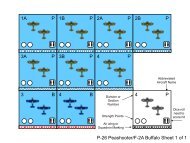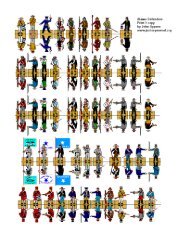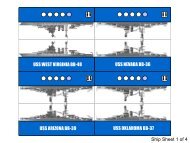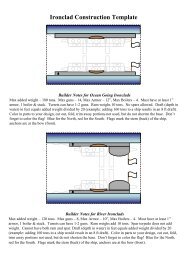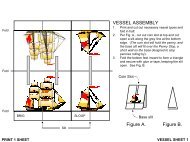Tora! Tora! Tora! The Attack on Pearl Harbor ... - Junior General
Tora! Tora! Tora! The Attack on Pearl Harbor ... - Junior General
Tora! Tora! Tora! The Attack on Pearl Harbor ... - Junior General
Create successful ePaper yourself
Turn your PDF publications into a flip-book with our unique Google optimized e-Paper software.
November 1941. War clouds are gathering in the<br />
Pacific. Tensi<strong>on</strong>s have been increasing between Japan<br />
and the US since Japan‟s invasi<strong>on</strong> of China in 1931.<br />
<str<strong>on</strong>g>The</str<strong>on</strong>g> US has enacted an oil embargo against Japan<br />
following the invasi<strong>on</strong> of French Indochina in 1940.<br />
Diplomatic negotiati<strong>on</strong>s are at an impasse.<br />
Anticipating hostilities, the Imperial Japanese Navy<br />
has planned a surprise attack against US forces at <strong>Pearl</strong><br />
<strong>Harbor</strong>, HI. US intelligence has intercepted coded<br />
Japanese messages and has c<strong>on</strong>cluded that an attack is<br />
likely somewhere in the Pacific, most likely in the<br />
Philippines, between December 1 st and 10 th . As a<br />
precauti<strong>on</strong>, the Alert Status <strong>on</strong> the Hawaiian island of<br />
Oahu has been raised from peacetime Alert Level 0 to<br />
Alert Level 1. Limited resources are available to<br />
selectively increase the Alert Level to 2 or 3, but<br />
extended increases in alert levels will unnecessarily<br />
tire men and c<strong>on</strong>sume limited supplies.<br />
<str<strong>on</strong>g>Tora</str<strong>on</strong>g>! <str<strong>on</strong>g>Tora</str<strong>on</strong>g>! <str<strong>on</strong>g>Tora</str<strong>on</strong>g>!<br />
<str<strong>on</strong>g>The</str<strong>on</strong>g> <str<strong>on</strong>g>Attack</str<strong>on</strong>g> <strong>on</strong> <strong>Pearl</strong> <strong>Harbor</strong>, December 1941<br />
<str<strong>on</strong>g>Tora</str<strong>on</strong>g>! <str<strong>on</strong>g>Tora</str<strong>on</strong>g>! <str<strong>on</strong>g>Tora</str<strong>on</strong>g>! is a game played in two parts – a strategic planning phase followed by a tactical attack phase. US<br />
players must decide how to employ limited forces in and around <strong>Pearl</strong> <strong>Harbor</strong> over the 10 day vulnerability period.<br />
Japanese players must select the timing, directi<strong>on</strong>, and compositi<strong>on</strong> of the attack in order to inflict enough damage to<br />
prevent the US Pacific Fleet from interfering with future Japanese war plans in Southeast Asia.<br />
US Forces<br />
US Forces<br />
Unit Scores Hit Locati<strong>on</strong><br />
P-40 Warhawk 4-6 Hickam / Wheeler<br />
P-36 Hawk 5-6 Hickam / Wheeler<br />
P-26 Peashooter 6 Hickam / Wheeler<br />
F-4F Wildcats 4-6 Kaneohe / Ewa<br />
F-2A Buffalo 6 Kaneohe / Ewa<br />
Ship AAA Batteries 6 <strong>Pearl</strong> <strong>Harbor</strong> Anchorage<br />
Shore AAA Batteries 6 Oahu Z<strong>on</strong>es 2SE and 2SW<br />
USS Lexingt<strong>on</strong> (CV-2)<br />
USS Enterprise (CV-6)<br />
USS Nevada (BB-36)<br />
USS Oklahoma (BB-37)<br />
USS Pennsylvania (BB-38)<br />
USS Ariz<strong>on</strong>a (BB-39)<br />
Oahu and <strong>Pearl</strong> <strong>Harbor</strong><br />
USS Tennessee (BB-43)<br />
USS California (BB-44)<br />
USS Maryland (BB-46)<br />
USS West Virginia (BB-48)<br />
USS Utah (AG-16)<br />
USS Oklahoma begins to capsize, while USS Ariz<strong>on</strong>a’s<br />
magazine explodes, by artist Tom Freeman<br />
US aircraft are arranged in groups of two to four fighters<br />
per 2”x2” token or “unit” and c<strong>on</strong>sist of 96 P-40<br />
Warhawks (24 units), 36 P-36 Hawks (12 units), 14 P-26<br />
Peashooters (7 units), 20 F-4F Wildcats (10 units), and 8<br />
F-2A Buffalos (4 units). <str<strong>on</strong>g>The</str<strong>on</strong>g> US Navy ships in play are<br />
the Pacific Fleet battleships and other vessels that were<br />
originally anchored around Ford Island:<br />
USS Raleigh (CL-7)<br />
USS Detroit (CL-8)<br />
USS Neosho (AO-23)<br />
USS Tangier (AV-8)<br />
USS Vestal (AR-4)<br />
Z<strong>on</strong>es: <str<strong>on</strong>g>The</str<strong>on</strong>g> playing area is divided up into 12 z<strong>on</strong>es resembling a three ring target cut into quadrants. Z<strong>on</strong>e 1: <strong>Pearl</strong> <strong>Harbor</strong><br />
and Ford Island, subdivided into quadrants 1NW, 1NE, 1SW, 1SE; Z<strong>on</strong>e 2: Surrounding island of Oahu, subdivided into<br />
quadrants 2NW, 2NE, 2SW, 2SE; Z<strong>on</strong>e 3: Pacific waters adjacent to Hawaii subdivided into quadrants 3NW, 3NE, 3SW,<br />
3SE.<br />
Airfields: <str<strong>on</strong>g>The</str<strong>on</strong>g>re are four airfields around Oahu in Z<strong>on</strong>e 2: USAAF airfields Hickam (2SE) and Wheeler (2NW), and NAS<br />
Kaneohe (2NE) and MCAS Ewa (2SW). Wheeler and Hickam are presented by 8”x10” sheets of gray c<strong>on</strong>structi<strong>on</strong> paper,<br />
with room for 20 aircraft units (4x5), though additi<strong>on</strong>al aircraft can be stati<strong>on</strong>ed there if parked “wingtip-to-wingtip” (i.e.
stacked <strong>on</strong> top of <strong>on</strong>e another). <str<strong>on</strong>g>The</str<strong>on</strong>g> smaller Marine and Navy fields<br />
at Ewa and Kaneohe use 4”x10” half sheets, with room for 10 units<br />
(2x5) or more if stacked.<br />
Anti-Aircraft Artillery (AAA) Batteries: Fort Barrette and Fort Weaver<br />
(2SW) and Fort Closs<strong>on</strong> and Fort Auha (2SE) can <strong>on</strong>ly engage targets<br />
in their z<strong>on</strong>e.<br />
Navy Facilities: Z<strong>on</strong>e 1 c<strong>on</strong>tains Ford Island and the surrounding<br />
harbor anchorages. <str<strong>on</strong>g>The</str<strong>on</strong>g> Navy Yard in Z<strong>on</strong>e 2SE c<strong>on</strong>sists of 12 dry<br />
dock, repair and machine shop, and fuel storage tank units. Also in<br />
Z<strong>on</strong>e 2SE is a channel c<strong>on</strong>necting the harbor with the Pacific Ocean.<br />
Refer to the end of these instructi<strong>on</strong>s for more detailed informati<strong>on</strong> regarding island setup.<br />
US Strategic Planning Phase<br />
Alert Readiness: Using the US Alert Planner (in Player Aids file), US players can selectively increase the alert status for<br />
Airfields, Ships and AAA Batteries, as well as plan for radar and patrol plane surveillance. <str<strong>on</strong>g>The</str<strong>on</strong>g> alert levels all start at “1”<br />
for each of the ten days. Players may add up to 6 „points‟ to each alert status. For example, increasing the Airfield Alert<br />
from Level 1 to Level 2 <strong>on</strong> Dec 3 rd costs 1 point; from Level 1 to Level 3 <strong>on</strong> Dec 4 th costs two more points. Likewise for<br />
increases to Level 2 <strong>on</strong> Dec 5 th and Level 3 <strong>on</strong> Dec 6 th for a total of 6 points. Similar 6 point increases can be made for<br />
Ship and AAA Battery Status. Note that alert levels apply to all units of that type, i.e. all airfields, all ships, etc.<br />
Alert Levels affect reacti<strong>on</strong> time and capability. US forces in Alert Level 1 can <strong>on</strong>ly begin to resp<strong>on</strong>d <strong>on</strong> Turn 4, or when<br />
Japanese forces reach Z<strong>on</strong>e 1, whichever occurs first. Likewise, Alert Level 2 forces can resp<strong>on</strong>d <strong>on</strong> Turn 3/Z<strong>on</strong>e 2, and<br />
Alert Level 3 forces <strong>on</strong> Turn 2/Z<strong>on</strong>e 3 (i.e. Turn + Alert = 5, Z<strong>on</strong>e = Alert). If radar or PBYs are searching the same<br />
sector from which IJN planes first attack, then all US forces may resp<strong>on</strong>d <strong>on</strong>e turn so<strong>on</strong>er (i.e. Turn + Alert = 4). On<br />
Turns 7 and 13, all Alert Levels are increased by 1 level.<br />
<str<strong>on</strong>g>The</str<strong>on</strong>g> higher the Alert Level, the more planes, ships, and guns are manned and ready to resp<strong>on</strong>d. See the chart below for<br />
specifics. Note the c<strong>on</strong>diti<strong>on</strong>s YOKE and ZEBRA under Ship Status. This refers to the degree to which a ship has closed<br />
watertight doors throughout the vessel. YOKE allows some doors to remain open to facilitate movement around the ship;<br />
ZEBRA closes all doors to improve battle damage survivability.<br />
Alert Level Airfield Status Ship Status AAA Battery Status<br />
1<br />
2<br />
3<br />
“Stand By”<br />
2 fighter units can launch/field/turn<br />
“Strip Alert”<br />
3 units can launch/field/turn<br />
“Combat Air Patrol”<br />
3 fighters from each field airborne<br />
<strong>on</strong> patrol overhead. 3 additi<strong>on</strong>al<br />
fighter units can launch/field/turn<br />
Minimum watch standers.<br />
C<strong>on</strong>diti<strong>on</strong> YOKE set. Roll 3d6<br />
(2d6 + 1d6 per Alert Level) to<br />
score AAA hits<br />
Full crew <strong>on</strong>board. C<strong>on</strong>diti<strong>on</strong><br />
YOKE set. Roll 4d6 to score<br />
AAA hits<br />
<strong>General</strong> Quarters, battle stati<strong>on</strong>s<br />
manned. C<strong>on</strong>diti<strong>on</strong> ZEBRA set<br />
(add 1 to ship strength). Roll 5d6<br />
to score AAA hits<br />
Sites manned, ammo in<br />
bunkers. Roll 3d6 (2d6 + 1d6<br />
per Alert Level) to score<br />
AAA hits<br />
Sites manned, ammo<br />
distributed. Roll 4d6 to score<br />
AAA hits<br />
Sites manned, guns loaded.<br />
Roll 5d6 score AAA hits<br />
Radar<br />
Newly installed radar is still unreliable. One search sector per day. Roll 1d6: Radar malfuncti<strong>on</strong>s and is<br />
inoperable <strong>on</strong> a given day <strong>on</strong> a roll of 1-2.<br />
Patrol Planes Limited numbers of PBY‟s available for l<strong>on</strong>g range patrol. One search sector can be assigned each day.<br />
Force Deployment: P-40s, P-36s, and P-26s may deploy in any mix to the USAAF airfields, while the F-4Fs and F-2As<br />
may deploy to any NAS/Marine Corps field. If stacking units, top most units launch before underlying units. If in Alert 3<br />
CAP, airborne fighters may stati<strong>on</strong> in any z<strong>on</strong>e. <str<strong>on</strong>g>The</str<strong>on</strong>g> aircraft carrier USS Enterprise has orders to deliver aircraft to Wake<br />
Island, while USS Lexingt<strong>on</strong> must deliver planes to Midway. Prior to departing, each carrier will need to be in <strong>Pearl</strong><br />
<strong>Harbor</strong> <strong>on</strong>e day. When in port, carriers anchor al<strong>on</strong>g the north side of Ford Island. Battleships anchor anywhere next to
Ford Island or al<strong>on</strong>g the Navy Yard. All other ships may anchor anywhere in Z<strong>on</strong>e 1. Ships may “nest” together, i.e. <strong>on</strong>e<br />
ship anchored next to another, though no more than two ships may nest together. To move, the outside ship must move<br />
first. Ship bases may overlap. Carriers cannot nest.<br />
IJN Forces<br />
Japanese forces c<strong>on</strong>sist of 120 B5N Kate torpedo bombers (30 units), 96 D3A Val dive bombers (24 units), and 84 A6M2<br />
Zero fighters (21 units), arranged in groups of two to four planes per 2”x2” unit.<br />
Imperial Japanese Navy<br />
Aircraft Scores Hit Ordnance Targets Notes<br />
A6M2 Zero Fighter 3-6 N<strong>on</strong>e Aircraft<br />
Strafing hits score the same as<br />
airborne hits<br />
D3A Val Dive Bomber 4-6 GP Bomb<br />
Aircraft (parked),<br />
Buildings, AAA<br />
If bombing stacked aircraft, score<br />
hits against top target first. If top<br />
B5N Kate Torpedo<br />
Bomber<br />
4-6<br />
4-6<br />
4-6<br />
GP Bomb<br />
AP Bomb<br />
Torpedo<br />
Aircraft (parked),<br />
Buildings, AAA<br />
Ships<br />
Ships<br />
unit destroyed, any remaining hits<br />
can be scored against lower unit<br />
Re-roll 6‟s for additi<strong>on</strong>al damage<br />
Need 2”x2” of open water next to<br />
target for torpedo run<br />
IJN Strategic Planning Phase<br />
Using the IJN <str<strong>on</strong>g>Attack</str<strong>on</strong>g>er Planner (in Player Aids file) IJN players must determine the following details of their attack:<br />
Day of <str<strong>on</strong>g>Attack</str<strong>on</strong>g> – pick a date between December 1 st and 10 th .<br />
Directi<strong>on</strong> of <str<strong>on</strong>g>Attack</str<strong>on</strong>g> – pick initial approach sectors, NE, NW, SE, or SW for each group of aircraft.<br />
Number and Compositi<strong>on</strong> of Waves – a wave may c<strong>on</strong>sist of any mix of Kates, Vals, and Zeros up to 48 units in a wave,<br />
and no more than 48 total units can be in play <strong>on</strong> the map at any <strong>on</strong>e time. A maximum of three waves may be launched,<br />
though no planes from Wave 2 may participate in Wave 3. See “Pressing Your Luck” notes below.<br />
Ordnance – <strong>General</strong> Purpose (GP) bombs can be used against parked aircraft, structures and AAA batteries. Armor<br />
Piercing (AP) bombs and torpedoes are used against ships. Zeros do not carry any ordnance other than machine<br />
guns/20mm cann<strong>on</strong>s. All bomber aircraft in a single unit carry the same type of ordnance, as indicated by an ordnance<br />
token placed beneath the unit token. Ordnance tokens are not limited and may be reused as necessary.<br />
Tactical <str<strong>on</strong>g>Attack</str<strong>on</strong>g> Phase<br />
After each side has made its plans, the IJN players first<br />
announce the day of the attack. US players refer to their Alert<br />
Status Planner and set forces according to the plan for that day.<br />
For Turn 1, IJN players then place all first wave planes <strong>on</strong> the<br />
Z<strong>on</strong>e 3 sector(s) per their attack plan. Based <strong>on</strong> their radar<br />
coverage, sea plane patrol sector and alert status, the Americans<br />
may or may not be able to resp<strong>on</strong>d. IJN players c<strong>on</strong>tinue to<br />
move their planes/attack targets turn by turn until the Americans<br />
are able to resp<strong>on</strong>d, after which IJN forces always move/attack<br />
first followed by US. Use the Turn Tracker (in Player Aids file)<br />
to keep track of the turns.<br />
Movement: Airplanes either move from <strong>on</strong>e z<strong>on</strong>e to another OR<br />
attack any <strong>on</strong>e target in their current z<strong>on</strong>e per turn. Taking off<br />
from an airfield counts as a move. Ships can move 1 base<br />
length per turn in the Z<strong>on</strong>e 1 harbor and the Z<strong>on</strong>e 2 channel; up<br />
to 3 lengths in Z<strong>on</strong>e 3 waters. Note that a single ship sunk in<br />
the channel blocks the channel.<br />
A formati<strong>on</strong> of Kates prepares to attack Battleship Row<br />
moored al<strong>on</strong>g the south east shore of Ford Island.
<str<strong>on</strong>g>Attack</str<strong>on</strong>g>s: Any target in the same z<strong>on</strong>e as the attacker can be engaged.<br />
Air-to-Air: A fighter unit may attack <strong>on</strong>e other air unit per turn, and any air unit can <strong>on</strong>ly be attacked <strong>on</strong>ce per turn by<br />
another air unit (this is easily tracked by first laying out all plane-against-plane pairings, then resolving combat).<br />
Fighters may dogfight with other fighters or attack bomber formati<strong>on</strong>s. If a fighter unit pairs off with another fighter,<br />
then a dogfight ensues and BOTH attacker and defender roll simultaneously for hits. Note that this does NOT count<br />
as the defenders‟ turn, and surviving defending units may move or attack freely during the sec<strong>on</strong>d half of the turn.<br />
Bombers do not dogfight and do not make defending rolls.<br />
Air-to-Ground: A bomber unit can make a single attack against <strong>on</strong>e target, rolling 1d6 for each strength point<br />
remaining, scoring a hit for each 5 or 6 rolled. If bombing stacked aircraft <strong>on</strong> the ground, score hits <strong>on</strong> top unit first,<br />
then the lower. Aircraft <strong>on</strong> the ground can <strong>on</strong>ly be attacked <strong>on</strong>ce per turn. For torpedo attacks, there must be a patch<br />
of open water 2” x 2” next to the l<strong>on</strong>g edge of the target ship‟s base (this is easily checked as the torpedo token is<br />
2”x2”). For armor piercing bomb attacks, re-roll any 6‟s for additi<strong>on</strong>al damage; c<strong>on</strong>tinue to re-roll until no 6‟s<br />
appear. After a bombing attack the ordnance token is set aside (may be reused for later waves). Fighters can attack<br />
<strong>on</strong>e target per turn, no limit <strong>on</strong> the total number of attacks. Zeros may also strafe aircraft units <strong>on</strong> the ground; any hits<br />
are scored the same as bombs.<br />
Ground-to-Air: AAA batteries and ships may engage aircraft in their z<strong>on</strong>e. Each battery or ship may attack <strong>on</strong>e air<br />
unit per turn. Multiple batteries and ships may engage the same target <strong>on</strong> the same turn. Navy Yard facilities can<br />
throw up small arms fire from windows and roof tops. If attacked, a targeted yard facility can roll 1d6 against the<br />
attacking unit. A six is needed to hit. In AAA Alert Level 1, roll 1d6 <strong>on</strong>ce; Alert Level 2 roll 1d6 twice; and in Alert<br />
Level 3 roll 1d6 up to three times. Regardless of the number of sixes rolled, <strong>on</strong>ly <strong>on</strong>e hit can be scored.<br />
Pressing Your Luck: Limited fuel, the time to rearm, launch and recover aircraft, approaching nightfall, the unknown<br />
whereabouts of the US carriers, fear of detecti<strong>on</strong>, increasing effectiveness of US defenses – all these factors influenced<br />
the Japanese decisi<strong>on</strong> as to whether or not to launch a third wave. Commencing with Turn 11, the IJN task force begins to<br />
be exposed to increasing risk the l<strong>on</strong>ger they remain in Hawaiian waters. From an ordinary deck of playing cards, select<br />
the Ace through Ten of Hearts and Diam<strong>on</strong>ds, and the Ace of Spades and of Clubs. Set aside the rest of the deck. Shuffle<br />
the red suits together with the Ace of Spades. If at least <strong>on</strong>e US carrier is NOT in port <strong>on</strong> the day of the attack, shuffle in<br />
the Ace of Clubs as well and place deck face down near the map board. At the end of each turn, starting with Turn 11,<br />
IJN turns over <strong>on</strong>e card. As l<strong>on</strong>g as a red card is turned over, fate c<strong>on</strong>tinues to favor the Japanese; however if a black<br />
card is turned over, the Japanese task force must hastily withdraw and all IJN aircraft in Z<strong>on</strong>es 1 – 3 fail to return to<br />
the carriers in time and are c<strong>on</strong>sidered lost. <str<strong>on</strong>g>The</str<strong>on</strong>g> game ends at this time!<br />
Outcome<br />
Winning: Japan desires further expansi<strong>on</strong> into Southeast Asia in early 1942. Japan wins a strategic victory if they are able<br />
to inflict enough damage at <strong>Pearl</strong> <strong>Harbor</strong> such that the US Pacific Fleet is out of acti<strong>on</strong> for the next six m<strong>on</strong>ths and unable<br />
to interfere, while preserving enough of their own carrier air power to c<strong>on</strong>duct follow-<strong>on</strong> operati<strong>on</strong>s. To counter Japanese<br />
plans, the USN must have at least five capital ships (carriers (CV) or battleships (BB)) available after the last IJN plane<br />
exists Z<strong>on</strong>e 3 (or IJN “luck” runs out). If the USN has fewer than five undamaged capital ships, it may be able to repair<br />
some damaged (but not sunken) ships in time if sufficient repair facilities remain intact. <str<strong>on</strong>g>The</str<strong>on</strong>g> more widespread the damage<br />
to ships, fuel farms, and machine shops, the slower the repairs and the fewer the ships available for any spring acti<strong>on</strong>.<br />
USN Strategic Victory While the US suffered losses, the damage is not great enough to prevent the US Pacific<br />
Fleet from deploying forces to Southeast Asia and disrupting Japanese strategic plans.<br />
IJN Tactical Victory Moderate US casualties sidelines of much of the Pacific Fleet for nearly a year, but with the<br />
remaining ships and repair capacity, the USN is able to deploy a small task force to thwart<br />
IJN plans to capture Port Moresby in May 1942 at the Battle of the Coral Sea.<br />
IJN Strategic Victory Severe damage at <strong>Pearl</strong> <strong>Harbor</strong> prevents the US from interfering in Japan‟s southward<br />
expansi<strong>on</strong> of the empire and securing access to vital raw materials in Southeast Asia needed<br />
to sustain Japan‟s war effort. But in order to claim a strategic victory, the IJN must preserve
Opti<strong>on</strong>al Intelligence Rules<br />
at least 50% of its carrier aircraft for future operati<strong>on</strong>s. If losses exceed 150 aircraft, the<br />
best the IJN can achieve is a tactical victory, but strategic defeat.<br />
Opti<strong>on</strong> 1: Can You Keep a Secret? Players c<strong>on</strong>duct the planning phase <strong>on</strong>e day, the tactical attack phase the next. See if<br />
the players are able to keep their plans secret from <strong>on</strong>e another, or successfully spread misinformati<strong>on</strong>. Prior to the start<br />
of the attack phase, allow USN (or USN and IJN) players to make any last minute changes to their plans.<br />
Opti<strong>on</strong> 2: Code Breaker! <str<strong>on</strong>g>The</str<strong>on</strong>g> US has intercepted a coded IJN message. Have the IJN players give the US players a<br />
cipher to work out. <str<strong>on</strong>g>The</str<strong>on</strong>g> code needs to make reference to the attack date with m<strong>on</strong>th and day with spelled numbers, for<br />
example, “December Tenth” or “Twelve Ten.” <str<strong>on</strong>g>The</str<strong>on</strong>g> message can be cryptic such as “Climb Mt. Nitaka Twelve Eight,”<br />
which was Yamamoto‟s actual coded message sent to Nagumo‟s fleet. See “Secret Codes for Kids” at<br />
http://www.topspysecrets.com/secret-codes-for-kids.html.<br />
Play Tips<br />
USN Capital Ships<br />
OK Damaged Sunk<br />
Outcome<br />
5+ NA NA USN Strategic Victory<br />
4<br />
4-6<br />
1-3<br />
0-2<br />
3-5 IJN Tactical Victory<br />
3<br />
5-7<br />
2-4<br />
0-2<br />
3-5<br />
but Strategic Defeat<br />
2<br />
7-8<br />
3-6<br />
0-1<br />
2-5<br />
1<br />
8-9<br />
4-7<br />
0-1<br />
2-5 IJN Strategic Victory<br />
0 5-10 0-5<br />
Navy Yard Damage 0-20% 21-40% 41-60% 61-80% 81-100%<br />
Number of Hits 0-12 13-24 25-36 37-48 49-60<br />
� This is a large game that works best with multiple players, with groups essentially playing four simultaneous<br />
games in each of the four compass quadrants.<br />
� Read all the directi<strong>on</strong>s, including those which are part of the download files! Examples of how to use the Alert<br />
and <str<strong>on</strong>g>Attack</str<strong>on</strong>g> Planners are included as part of the Player Aid file. In some cases, you will need to make multiple<br />
copies of the same sheet of tokens in a file. Remember, single token is equal to a unit. For example, two fighter<br />
units equal two tokens regardless of how many individual aircraft are <strong>on</strong> each token.<br />
� When selecting the aircraft for each IJN wave, use a piece of paper marked with the wave number and divided<br />
into the compass quadrants to initially hold the wave, using a separate piece of paper for each wave. This makes<br />
it easier to transport the wave to the map table from the planning area then sort them into the attack quadrants.<br />
When aircraft fly out of Z<strong>on</strong>e 3 and return to the carriers, put them back <strong>on</strong> the same sheet of paper. This makes<br />
figuring out which planes are eligible for the opti<strong>on</strong>al third wave easier.<br />
� On each turn, starting in Z<strong>on</strong>e 1, resolve combat first - pairing up attacker to target, then resolve movement.<br />
Repeat for Z<strong>on</strong>es 2 and 3. This minimizes c<strong>on</strong>fusi<strong>on</strong> over who has attacked and who has moved in a given turn in<br />
a given z<strong>on</strong>e. Remember there are lots of airplanes flying around!<br />
� When counting up IJN aircraft losses, d<strong>on</strong>‟t forget to count hits <strong>on</strong> units which were not completely shot down.<br />
For example, there may be a unit of Kates from the sec<strong>on</strong>d wave which took two hits out of four which is sitting<br />
<strong>on</strong> the Japanese players‟ table which would count as two aircraft lost. You may want to keep a running tally.<br />
� In the interest of time, you may want to limit the IJN to <strong>on</strong>ly two waves and/or change when (or even if) “Pressing<br />
Your Luck” becomes a factor.
Island Set Up for TORA! TORA! TORA!<br />
Two 5 x 7 ½ foot tables covered with blue cloth are recommended. Each quadrant of Z<strong>on</strong>e 2 Oahu is<br />
approximately 3 x 4 feet. Oahu and Ford Island can be made from green felt, poster board, or c<strong>on</strong>structi<strong>on</strong><br />
paper, or outlined in string or tape. <str<strong>on</strong>g>The</str<strong>on</strong>g> exact shape of each quadrant is not important as l<strong>on</strong>g as:<br />
(1) Each quadrant has sufficient room to place its specific airfield,<br />
(2) <str<strong>on</strong>g>The</str<strong>on</strong>g> resultant harbor is approximately 55 inches east-west and 46 north-south, and<br />
(3) <str<strong>on</strong>g>The</str<strong>on</strong>g> Channel c<strong>on</strong>necting the Z<strong>on</strong>e 1 <strong>Harbor</strong> to the Z<strong>on</strong>e 3 Pacific is 3 x 16 inches.<br />
Dimensi<strong>on</strong>s for specific features:<br />
Ford Island: 8 ½ x 22 inches <strong>Pearl</strong> <strong>Harbor</strong>: 55 x 46 inches<br />
Channel: 3 x 16 inches Hickam and Wheeler: 8 x 10 inches<br />
Ewa and Kaneohe: 4 x 10 inches<br />
Place Hickam Field in Z<strong>on</strong>e 2SE, Wheeler in 2NW, Ewa in 2SW and Kaneohe in 2NE. Place two AAA<br />
batteries near Ewa and two near Hickam. Place the 12 Navy Yard tokens anywhere al<strong>on</strong>g the harbor shore of<br />
Z<strong>on</strong>e 2SE.<br />
Use tape to mark the z<strong>on</strong>e quadrant boundaries. <str<strong>on</strong>g>The</str<strong>on</strong>g> channel is c<strong>on</strong>sidered to be part of Z<strong>on</strong>e 2SE.<br />
Special thanks to J<strong>on</strong> Oldham for his ship designs and Clive for his AAA battery.



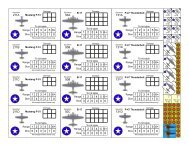
![US Infantry Squads {12 men] Wjuniorgeneralnrg](https://img.yumpu.com/47417569/1/190x245/us-infantry-squads-12-men-wjuniorgeneralnrg.jpg?quality=85)
